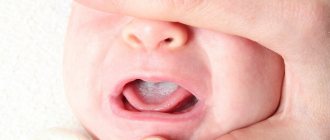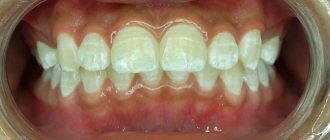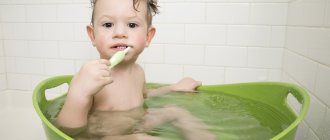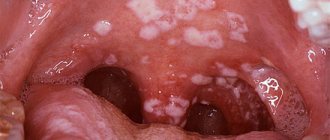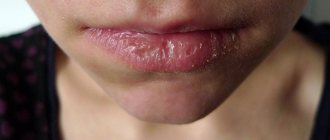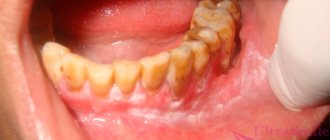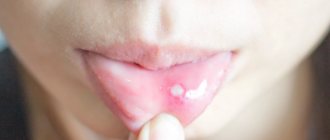Milium (horny cyst, whitehead, “millet”) is an epidermal cystic formation at the mouth of the hair follicle, looking like a small white grain. Typically, milia are localized on the face in areas with relatively thin skin, very rarely on the body, and exist for a long period without any changes. Milia are a fairly common cosmetic problem and can occur at any age. Whiteheads appear especially often during puberty; also often found in newborn babies (neonatal acne). Female representatives are more susceptible to the appearance of milia.
Causes of white spots on the lips of a newborn baby
The appearance of white spots on the lips of an infant may be due to:
- candidal stomatitis (thrush) - due to the activation of the opportunistic yeast-like fungus Candida. This is the most common cause of the appearance of white spots on the lips of children in the first year of life;
- bacterial stomatitis - an attack of microbes, usually strepto- or staphylococci, on the oral mucosa weakened by the provoking factor;
- herpetic infection - herpes simplex virus type I, activated against the background of a decrease in local or general immunity;
- allergic stomatitis - when the oral mucosa is exposed to substances to which the child has an abnormally high sensitivity.
Factors that create a favorable environment for the introduction of the pathogen and the development of the disease include:
- low immune defense;
- prematurity;
- artificial feeding;
- insufficient hygiene of the infant's oral cavity, maternal nipple, bottles, pacifiers, nipples;
- microtrauma of the mucous membrane - thermal, mechanical or chemical - in which an entrance gate for infection is formed;
- nutritional imbalance - lack of breast milk or a mixture of vitamins, macro- and microelements;
- difficulty passing air through the nasal passages - breathing through the mouth dries out the mucous membrane, increasing the risk of microtraumas and infections;
- pathologies of the digestive and endocrine systems - diabetes, hepatitis, dysbacteriosis.
For stomatitis to occur, a combination of two conditions is necessary: activation of the pathogen and predisposition of the mucous membrane to the disease due to the influence of the provoking factor.
Treatment of white plaque on a child’s tongue
A white coating on a child’s tongue is most likely ordinary food debris. If it is not removed with a damp cloth and spreads to the mucous membrane of the cheeks, then this indicates the development of an infectious process.
Why does a white coating appear on the tongue of a baby during breastfeeding? As a rule, this is thrush - a fungal infection caused by yeast-like fungi belonging to the genus Candida. A white coating covers the baby's tongue and gums, the inside of the lips and cheeks. Thrush often occurs in children under one year of age. The reason is the immature immune system of infants. Thrush is a contagious disease, so to avoid it, bottles and pacifiers must be thoroughly sterilized. Older children also get thrush. Children with weakened immune systems and asthmatic children using inhaled corticosteroids are at risk. Treatment of white plaque on a child's tongue is carried out with local antifungal drugs. Important: medications should be prescribed exclusively by a doctor, since a similar picture may be a symptom of another condition in which antifungal drugs are not required. For example, diseases caused by the Coxsackie virus are often accompanied by the appearance of white “spots” on the tongue. In fact, these are painful ulcerations that disappear on their own within 3-5 days without any treatment. Therefore, if you find a white coating on your child’s tongue, you should consult a doctor and not self-medicate.
In infants, the surface of the tongue may be covered with a colored coating. How to treat a yellow coating on the tongue of a newborn depends on the condition that is accompanied by this symptom. For example, sometimes the tongue becomes coated with a colored coating from certain baby formulas. Just change your diet and your tongue will clear up. However, yellow plaque may also indicate problems with the gastrointestinal tract and respiratory infections. In these cases, treatment of the underlying disease is carried out.
Associated symptoms
The appearance of white spots on the lips may be accompanied by associated symptoms.
- The appearance of vesicles in herpes may be preceded by a sensation of itching, burning, tingling at the site of the virus attack.
- Aphthae (erosions) formed during bacterial or fungal stomatitis are very painful, especially when sucking, irritation with milk or food.
- Massive lesions of the mucous membrane by any type of pathogen can be accompanied by lethargy, refusal to eat, crying, and drooling.
In the absence of treatment or the addition of a secondary infection, the aphthae can undergo necrosis, to which the baby’s body reacts with symptoms of general intoxication: a rise in temperature to 39-40 ° C, anxiety, fever, and an unpleasant odor from the baby’s mouth.
Immunity-weakening diseases - the root causes of white spots on a child’s lips are manifested by organ or systemic symptoms: dyspeptic disorders, pain, bloating, frequent regurgitation, etc.
How to deal with tongue coating
Thorough cleaning of the tongue is the main hygienic measure aimed at eliminating plaque. Clinical trials have shown that regular tongue cleaning reduces bacteria and bad odor by 75%.
How to get rid of dry mouth and white coating on the tongue:
- use a special scraper - effective tongue cleaning reduces plaque by 40%;
- drink enough water;
- eat foods containing coarse fiber (for example, apples, carrots);
- quit smoking;
- do not abuse alcoholic beverages;
- Healthy food;
- rinse your mouth after eating.
By following these simple rules, you can forever “say goodbye” to the coating on your tongue and forget about bad breath.
Related services: Pediatrician consultation
Diagnostic methods
Upon examination, a specialist can determine that the child has stomatitis. However, identifying the root cause of its occurrence and the type of damaging factor can be difficult for him.
For this purpose, additional examination is carried out:
- blood for polymerase chain reaction - to determine the nature of the pathogen, allows you to confirm herpes;
- scraping from the aft - to identify the pathogen (streptococcus, staphylococcus, etc.), its susceptibility to antibiotic therapy;
- performing allergy tests, blood testing for immunocomplexes, conducting an immunogram - to study the body’s response to allergens.
According to indications, a hardware ultrasound examination, consultation with a pediatrician, and specialists are prescribed.
How to treat white spots on the lips of a baby?
According to experts, the use of traditional medicine methods is not the best option to combat the problem. In order not to harm the child, it is not recommended to perform certain manipulations.
- Treat with a finger wrapped in gauze - this can further damage the delicate mucous membrane of the child’s lips and aggravate the problem. Use cotton swabs or pieces of sterile cotton wool.
- To treat aphthae, use a solution of brilliant green, tincture of iodine, or fucorcin - there is a high probability of causing a chemical burn.
- Use infusions of medicinal herbs - when treating or irrigating the mucous membrane, some of the solutions will inevitably be swallowed by the child, which can negatively affect digestion.
- Apply honey to the aphthae. Firstly, there is a high risk of the baby developing an allergic reaction. Secondly, sweets, being an excellent breeding ground for bacteria and fungi, stimulate their growth and development.
The basic principles of treating white spots in a child are maintaining good oral hygiene, gentle nutrition, and using medications as recommended by a pediatrician according to the child’s age.
- After each feeding, the oral cavity is washed using an irrigation bottle or bulb. To do this, the child is placed on his side, and the remaining milk or formula is removed with a gentle pressure of water.
- Then the top layer of plaque is removed from the spots and treated with a product prescribed by the pediatrician, taking into account the type of pathogen.
Local medications that are used to treat children for white spots include several groups aimed at combating a specific problem.
- If thrush is confirmed, pediatricians may prescribe to a newborn: Candida solution to treat white spots on the lips;
- Such babies are often advised to treat with a 2% aqueous solution of baking soda.
- Six-month-old children and older may additionally be prescribed Miramistin, Fluconazole, Diflucan.
- babies over one year old are treated with Lugol, Nystatin.
- Kamistad Baby, Kalgel - antiseptics containing painkillers;
- for children in the first year of life - Viferon gel, oxolinic ointment;
With widespread or severe stomatitis, local treatment alone may not be enough, and the pediatrician decides to additionally prescribe the drug for internal use.
- Antiviral, antibacterial, antifungal - depending on the type of pathogen.
- Allergic stomatitis requires antihistamines for newborns: Suprastin, Tavegil.
- Febrile fever is relieved with antipyretics, approved for use in children of the first year of life in the form of rectal suppositories, suspensions: Daleron, Ibuprofen, Nurofen, Calpol, etc.
- The vitamin and mineral balance of the body is replenished with age-appropriate treatment and prophylactic complexes.
Strictly adhere to the age-related dosages recommended by the doctor: the use of medications intended for older children can be harmful, and medications intended for younger children will not have the desired effect.
Treatment of milia
Milia do not go away on their own; it is almost impossible to get rid of them with the help of cosmetics. Under no circumstances should you squeeze out milia yourself, as this will damage the hair follicle and sebaceous gland. Such self-medication often leads to the subsequent formation of a larger acne or the addition of an infection, which can cause the formation of a rough scar.
Treatment of milia is carried out by a dermatologist and consists of opening and removing the cyst capsule with its contents. The choice of removal method depends on the location, number, size and depth of the milia. For single milia, mechanical removal is carried out (using a sterile needle and curettage) with preliminary and subsequent antiseptic treatment of the skin. Small wounds left after such a procedure heal on their own without leaving a trace.
For multiple whiteheads, modern methods are used - removal of milia with a laser, radio wave method or electrocoagulation. The crusts formed at the cauterization site disappear on their own within 10-14 days. Removing more than 10 elements at one time is not recommended to avoid significant trauma to the skin and disruption of the sebaceous glands.
Prevention measures
To prevent the development of fungal, bacterial or viral stomatitis, follow the recommendations:
- comply with hygiene requirements - wash hands, toys, boil bottles and nipples, pacifiers;
- treat the mother's nipple with a soda solution before feeding - targeted prevention of thrush;
- limit sweets;
- support intestinal microflora, preventing the development of dysbiosis;
- do not give crackers to prevent damage to the mucous membrane;
- use soft toothbrushes and pastes containing lysozyme and lactoferrin - enzymes that help increase local immunity of the oral cavity;
- activate the immune defense of the child’s body - harden it, conduct preventive courses of vitamin preparations.
If white spots appear on the child’s lips, contact a specialist.
